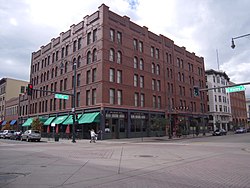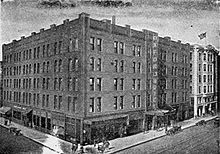| The Oxford Hotel | |
| U.S. National Register of Historic Places | |
| Colorado State Register of Historic Properties | |
 | |
  | |
| Location | 1612 17th St., Denver, Colorado |
|---|---|
| Coordinates | 39°45′7″N 104°59′55″W / 39.75194°N 104.99861°W / 39.75194; -104.99861 |
| Area | 0.5 acres (0.20 ha) |
| Built | 1891 |
| Architect | Multiple |
| NRHP reference No. | 79000590 |
| CSRHP No. | 5DV.47.62 |
| Added to NRHP | April 17, 1979 |
The Oxford Hotel is a historic building in Denver, Colorado, which was designed by early Denver architect Frank Edbrooke, and built in 1891. It was listed on the National Register of Historic Places in 1979. The Cruise Room is a hotel bar with historic art deco interior, that was operated as an illicit speakeasy.
History
The Oxford Hotel was built in 1891.
In February 1908, Bill Haywood and two other officers of the Western Federation of Miners were secretly held overnight in adjacent rooms in the Oxford, by the Denver police. Their stay at the Oxford was kept secret so their supporters could not try to block their extradition early the next morning by a special train to Idaho, to be tried for conspiracy in the assassination of a former governor of Idaho.
In the 1950s, the Oxford Hotel was considered a flophouse. In the 1980s a new owner improved the hotel.
The hotel restaurant was operated by McCormick's Fish House from when they signed a lease with the Oxford Hotel in 1987 until 2016. Today, Urban Farmer Steakhouse operates as The Oxford Hotel's restaurant partner.
The Cruise Room
The Cruise Room is a bar located within the Oxford Hotel, considered a historic, upscale cocktail lounge, and known for its preserved Art Deco interior. It officially opened the day after prohibition ended. The bar is a single, windowless room, on the ground floor of The Oxford Hotel, located between the Corner Bar at McCormick's Fish House and the hotel lobby.
History

The bar opened as part of the Oxford Hotel in 1891, and was known for its martinis, though not originally named the Cruise Room.
During prohibition, The Cruise Room operated as an illicit speakeasy. Employees know of secret paneling and tunnels.
The Cruise Room was officially opened (with its full interior and full bar) the day after Prohibition ended. As an extension of the hotel and its restaurant, this bar has operated continually since its official opening.
The Cruise Room has remained an independent establishment, managed in a partnership between the operator of the restaurant (now Urban Farmer, owned by Sage Restaurant Collection) and the Oxford Hotel.
In 2012, the Cruise Room was restored, including historically accurate paint and light-pumpkin color. The marble floor was also replaced. This restoration was initiated by owner/developer Dana Crawford, who became a partner in the Oxford Hotel in 1980.
The drinks menu was also updated, emphasizing contemporary "mixology", and includes drinks like "Pineapple Julep", "Whiskey Clover Smash", and "Pomegranate Sling". The bar also offers more than a dozen martinis, served from oversized martini shakers.
Interior design
The interior was modeled after a lounge on the ocean liner RMS Queen Mary. The design was by Denver architect Charles Jaka, and featured Art Deco bas-relief wall panels that stretch from floor to ceiling, created by Denver artist Alley Henson. Each panel depicts a "toast" from a different culture around the world. The interior has an unusual color juxtaposition, with red lighting shining down on chrome trim and historically accurate light-pumpkin-colored walls. The entire room is subtly shaped like a wine bottle.
One of the wall panel depicts Germans toasting, and features Hitler. This panel was taken down during World War II, and was replaced by one depicting Ireland.
References
- ^ "National Register Information System". National Register of Historic Places. National Park Service. March 13, 2009.
- ^ Official website
- "Directory of Railroad Properties in the Colorado State REgister of Historic Properties, Fourth Edition" (PDF). History Colorado. Office of Archaeology and Historic Preservation. Retrieved July 29, 2016.
- J. Anthony Lukas, Big Trouble: A Murder in a Small Western Town Sets Off a Struggle for the Soul of America. New York: Simon and Schuster, 1997; pg.260.
- ^ Flynn, Katherine (August 14, 2014). "[Historic Bars] The Cruise Room in Denver". PreservationNation Blog. The National Trust for Historic Preservation. Retrieved May 17, 2014.
- ^ Calhoun, Patricia (October 17, 2012). "Cruise Room Gets a Facelift – but the History Remains". www.Westword.com. Westword Magazine. Retrieved May 17, 2015.
- "The Cruise Room". The Oxford Hotel. Retrieved May 17, 2015.
- ^ "The Cruise Room Bar, 10Best Says". 10Best. USA Today. Retrieved May 17, 2015.
- http://www.theoxfordhotel.com/wp-content/uploads/2014/07/Cruise-Mixology-List.pdf
- Noel, Thomas Jacob; Norgren, Barbara S. (1987). Denver, the city beautiful and its architects, 1893–1941. Denver, CO: Historic Denver, Inc. p. 77. ISBN 978-0-914248-04-0.
- "Cruise Room". Denver.org. Retrieved May 17, 2015.
| U.S. National Register of Historic Places | |
|---|---|
| Topics | |
| Lists by state |
|
| Lists by insular areas | |
| Lists by associated state | |
| Other areas | |
| Related | |